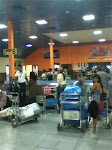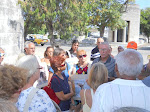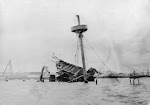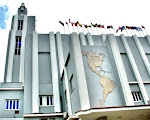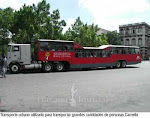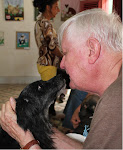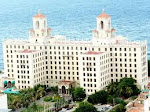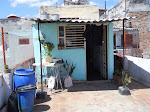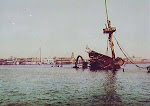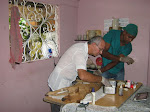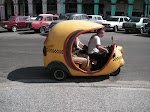Las Terrazas
Less than an hour's drive west of Havana puts you well into Pinar del Río, Cuba's westernmost province. The little town of Las Terrazas is not very old, but its big attraction is nature, not history. In 1984, UNESCO designated the area as one of its Biosphere Reserves, and the Cuban government built the little town to accommodate the tourists it would certainly draw. As our van left the main highway, we bounced along increasingly narrower roads, climbing into the Sierra del Rosario Mountains.
We seemed to be in an ageless jungle with a huge variety of lush greenery, but our guide told us that this was all a huge coffee plantation not so many years before. For whatever reasons, the coffee growers left this region for Cuba's eastern provinces. Coffee horticulture gone, the land was bare and terraced for a short time until the tropical jungle quickly reclaimed its own. Now you have to look hard to see evidence of the terraces, hidden by the thick leaves, vines and branches.
The small village of Las Terrazas has a super restaurant called EL Romero, a few gift shops full of locally made artworks, and a stunning tourist hotel with an open air lobby to take advantage of the tropical climate. Hikers' paths wind through the mountain, crossing streams, climbing and falling. The day we were there, tourists decked out as hikers trod every visible trail.
We had dinner at El Romero, and our guide for the day was Tito, the man who had developed the restaurant for its owner, the Cuban government. Tito's specialty is using locally available foods, and the menu is completely created using only foods grown locally. For example, the delightful salad was made of lotus shoots which were harvested from plants growing in the shallow waters of the mountain lake we gazed at from the restaurant balcony. We bought books of El Romero recipes, presented on compact discs, and when I got home I Googled for a source of lotus shoots. All I could find was one source on the other side of the world in Burma. I have a suggestion for Fidel and Raul: export lotus shoots, and you'll have more export business. I'll be the first customer.
As we dined, peafowl and other domestic birds paraded the grounds around the restaurant. They knew they were safe as the "local foods" served at El Romero are plant based foods only--no carnivores, please.. The other dishes rivaled the salad, and we all ordered something different, and we shared among our group. Tito was not only the creator of a terrific dinner, he was a local celebrity, and our van was waved through any gates where others had to pay an entrance fee.
As it happens, the island of Cuba is at its narrowest at Las Terrazas. It's only 40 miles from the Gulf of Mexico and Florida Straits to the north to the Caribbean Sea to the south. And, how fortunate the Sierra del Rosario Mountains are right there. We got back on the bus and ground up a little road, sometimes no more than two tire tracks and a little gravel. At the summit was the old head office of the coffee plantation, and everywhere you looked it was downhill. But, most surprising you could see both bodies of water, the Gulf and the Sea, in the clear times between the passage of wispy little clouds. Yes, the entire width of the island was within our range of vision.
Most people will agree Cuba is a beautiful place, and those who have visited Las Terrazas understand why UNESCO chose this beautiful area as one of its Biological Reserves.
Les Inglis
Friday, February 18, 2011
Friday, February 4, 2011
The First Day
The First Day
Well, today is the first day of the rest of my life. How many times have I heard that exhortation to begin anew--that reminder that opportunity offers itself every day if only we can recognize it when it knocks?
For a guy who retired sort of early without much of a plan, I've had a long time to try things to occupy me, but not many of the ways I have busied myself have been filled with meaning and importance. Well, that is until a Wednesday in November, 2005 when I came to know Aniplant, an animal protection group in Havana Cuba. Surely that day turned out to be the first day of the rest of my life.
I met Nora Garcia, Aniplant's President that day, and she began to show me the very different world Cuba's animals face. I thought I knew something about animal protection before that day, but I've been learning more every day since then. Cuba, like many smaller, poorer countries, has too many dogs and cats loose on the streets. Some have homes, and others face life as homeless waifs hoping to find something to eat, and coping with illness and occasional abuse.
Meeting Nora then was the start of a long cooperation that has included furnishing drugs and supplies for vets, funding anesthesia meds for Aniplant's spay-neuter campaigns, hosting her in our home so she could meet local contributors, traveling to and participating in Expo 2010, a convention for animal shelter operators, and visiting a number of Cuban activities associated with animals. As time has gone by, there has been more and more to do.
It didn't abate when my wife, Charlene, became active in Aniplant. In addition to being the only good typist in our house, she is the most informed person on animal issues I know. She believed, rightly so, we should formalize our work, and she singlehandedly created, applied for, and/or secured our 501(c)(3) from the IRS, our incorporation from the state, our registration as a charity in the State of Florida, our website (http://theaniplantproject.org) , and today she acts as critical proofreader of my scribblings in this blog.
We see no and seek no end to our task of helping Aniplant. Thus that day in 2005, whether we could have guessed it or not, was the first day of the rest of both of our lives.
Les Inglis
Well, today is the first day of the rest of my life. How many times have I heard that exhortation to begin anew--that reminder that opportunity offers itself every day if only we can recognize it when it knocks?
For a guy who retired sort of early without much of a plan, I've had a long time to try things to occupy me, but not many of the ways I have busied myself have been filled with meaning and importance. Well, that is until a Wednesday in November, 2005 when I came to know Aniplant, an animal protection group in Havana Cuba. Surely that day turned out to be the first day of the rest of my life.
I met Nora Garcia, Aniplant's President that day, and she began to show me the very different world Cuba's animals face. I thought I knew something about animal protection before that day, but I've been learning more every day since then. Cuba, like many smaller, poorer countries, has too many dogs and cats loose on the streets. Some have homes, and others face life as homeless waifs hoping to find something to eat, and coping with illness and occasional abuse.
Meeting Nora then was the start of a long cooperation that has included furnishing drugs and supplies for vets, funding anesthesia meds for Aniplant's spay-neuter campaigns, hosting her in our home so she could meet local contributors, traveling to and participating in Expo 2010, a convention for animal shelter operators, and visiting a number of Cuban activities associated with animals. As time has gone by, there has been more and more to do.
It didn't abate when my wife, Charlene, became active in Aniplant. In addition to being the only good typist in our house, she is the most informed person on animal issues I know. She believed, rightly so, we should formalize our work, and she singlehandedly created, applied for, and/or secured our 501(c)(3) from the IRS, our incorporation from the state, our registration as a charity in the State of Florida, our website (http://theaniplantproject.org) , and today she acts as critical proofreader of my scribblings in this blog.
We see no and seek no end to our task of helping Aniplant. Thus that day in 2005, whether we could have guessed it or not, was the first day of the rest of both of our lives.
Les Inglis
Subscribe to:
Posts (Atom)
